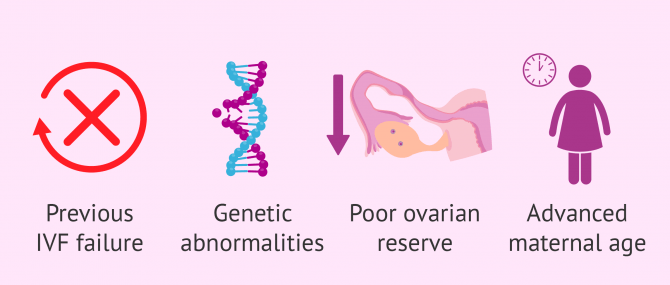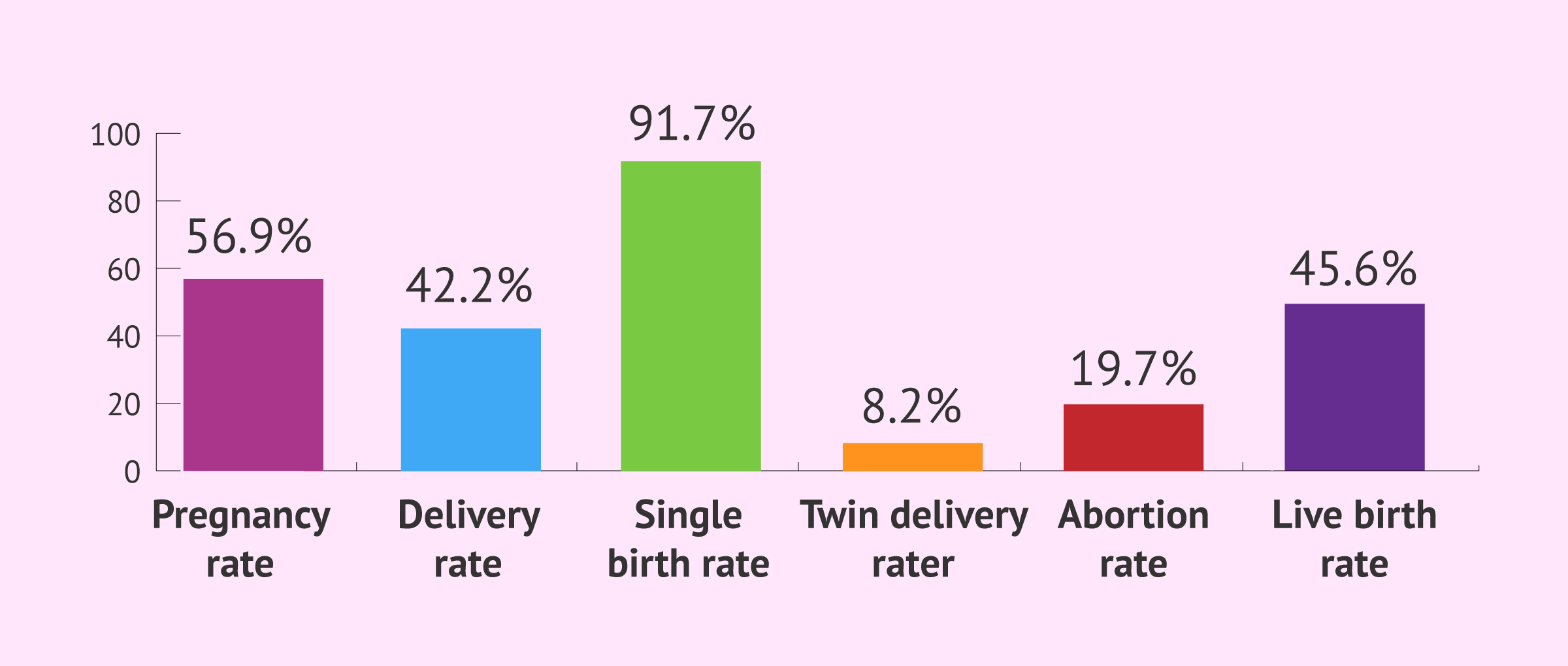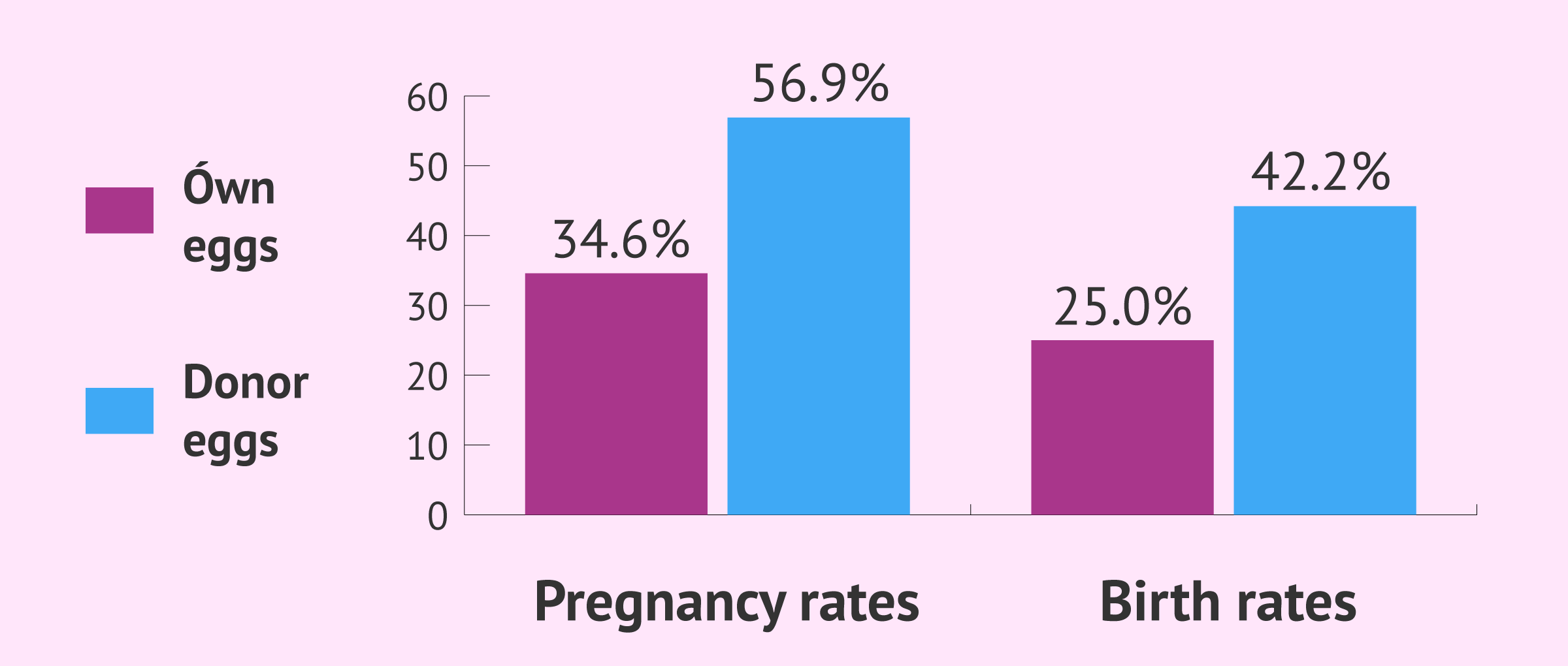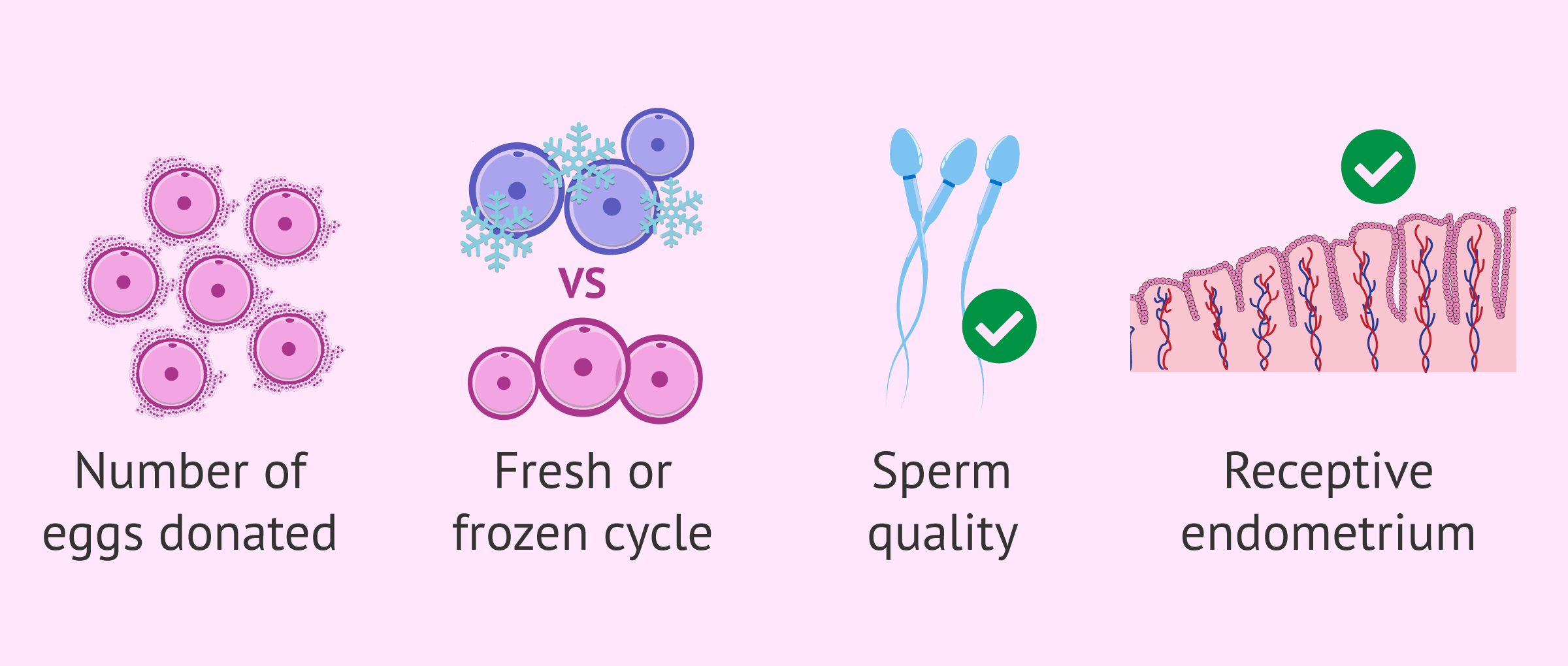In vitro fertilization (IVF) with egg donation or oocyte donation is one of the assisted reproduction treatments with the best success rates. Thanks to it, many women manage to become mothers when it hadn’t been possible with their own eggs.
The high probability of success is because the eggs come from young, healthy women and are therefore of good quality. This makes it easier to get pregnant the first time round.
In this article, we are going to give information from the last statistical report published by the Spanish Fertility Society (SEF), which gathers all the results obtained by the Spanish assisted reproduction clinics in 2022(National Registry of Activity 2022- SEF Registry
Provided below is an index with the 8 points we are going to expand on in this article.
- 1.
- 2.
- 2.1.
- 3.
- 4.
- 5.
- 5.1.
- 5.2.
- 5.3.
- 5.4.
- 5.5.
- 5.6.
- 5.7.
- 5.8.
- 5.9.
- 5.10.
- 6.
- 7.
- 8.
Reasons for IVF with egg donation
In 2022, 12,110 fresh egg reception cycles were performed in Spain with a total of 5,102 embryo transfers.
The main causes that led women to opt for this egg donation treatment in order to become mothers were the following:
- Advanced maternal age
- over the years, the number and quality of eggs decreases. After the age of 35, it is more common for eggs to begin to accumulate mutations, which compromises the viability of embryos or can even lead to repeated miscarriages.
- Low ovarian reserve or no ovarian function
- due to primary ovarian failure, premature ovarian failure, menopause or ovarian surgery.
- Genetic mutations
- in cases of hereditary genetic disease that can be transmitted to the offspring and that cannot be detected by preimplantation genetic diagnosis (PGD).
- Repeated IVF failures with own eggs
- low response to ovarian stimulation, poor egg and/or embryo quality (as in the case of patients with endometriosis), fertilization and/or implantation failure or repeated miscarriages are the main reasons why pregnancy may not be achieved in IVF treatment.
In summary, either because of the absence of eggs or because of poor egg quality, when a woman cannot get pregnant with her own eggs, she can resort to egg donation treatment to achieve motherhood.
Percentage of success with egg donation
The success rates of IVF with donated eggs are very good, as shown by the data published by the SEF in the 2022 registry:
- Pregnancy rate
- 56.9% (embryo transfer pregnancies).
- Delivery rate
- 42.2% (embryo transfer deliveries).
- Single birth rate
- 91.7% (single deliveries per total number of deliveries).
- Twin delivery rate
- 8.2% (twin births per total number of births).
- Miscarriage rate
- 19.7% (miscarriages per number of pregnancies).
- Live newborn rate
- 45.6% (babies born by embryo transfer).
In addition, there were no major differences in pregnancy and delivery rates between women with different age ranges, i.e., between women younger than 35 years and women older than 40 years. Therefore, the age of the recipient woman is not an important factor in achieving success with oocyte donation.
When comparing these success rates with those of IVF with own eggs, it is possible to appreciate the enormous advantage of ovodonation in achieving pregnancy, since the pregnancy rate for transfer with own eggs was 34.6% and the delivery rate for transfer was only 25.0%.
This doesn´t mean that egg donation should be requested from the outset. Rather, each particular case should be carefully studied and individualized. After performing the fertility study and the corresponding tests, a diagnosis of the cause of infertility must be made in order to prescribe the most suitable treatment for the couple or woman seeking pregnancy.
Number of attempts required for success
One of the questions that most concerns egg donation patients is how many attempts will be necessary to achieve the long-awaited pregnancy.
The vast majority of these patients are people who have already undergone several IVF cycles and accumulated several failures, with the emotional and economic wear and tear that this entails.
Since the cumulative pregnancy rate per cycle is around 70%, it is very likely to achieve first-time success with ovodonation.
In addition, in case of failure to obtain a positive result in the first attempt, it is estimated that the probability of success reaches approximately 90% after three attempts of embryo transfer.
However, it should be noted that it is very difficult to determine the exact number of attempts that each patient will need, as many factors influence the treatment.
Statistical data in this article shall not be used to imply or predict an outcome certainty to a specific individual within a population at risk.
Implicating factors
The most important factor in virtually all IVF treatments is oocyte quality.
The main reason why egg donation has such high success rates is that the age of egg donors never exceeds 35 years, and it is stipulated by law in many countries.
In fact, in many centers, age is restricted a little more to ensure good results and the limit for candidates is 30 years old.
In addition to being young, medical and psychological tests are also carried out to verify that the donors do not have any known alterations that could affect their health and fertility.
Other factors that influence the success of IVF with donor eggs include:
- Number of embryos transferred
- ovodonation can be shared (the recipient receives a limited number of eggs) or exclusive (all eggs retrieved from the donor are for the use of the recipient). Obviously, the greater the number of eggs, the greater the availability of embryos for transfer or freezing, and the higher the pregnancy rate per cycle.
- Fresh or frozen cycle
- donor eggs can come from a bank and be frozen or it is also possible to synchronize the donor with the recipient and make a fresh donation. Success rates are very similar, but are still slightly higher when performing a fresh cycle.
- Semen quality
- if the male has fertility problems or his sperm are aneuploidy carriers, the probability of success may also decrease.
- Recipient uterus
- it is necessary for the woman to have a receptive endometrium so that the embryo can implant after the transfer. In addition, other problems such as uterine malformations or alterations of the immune system can also affect the success of ovodonation.
- Assisted reproduction clinic
- finally, fertility centers may have different success rates depending on their working protocols, experience of gynecologists and embryologists, etc.
You can learn more about success rates and all the factors involved in a fertility treatment in the following article: An analysis of success rates in assisted reproduction treatments
Evolution of egg donation
The first pregnancy from an egg donation was achieved by Dr. Alan Trounson, but it was Dr. Lutjen who a year later, in 1984, achieved the first full-term pregnancy in a woman who had ovarian failure, i.e. her ovaries were not functioning. Without this technique she would not have been able to become a mother.
All assisted reproductive techniques are relatively young, but the most recent one to come into use is egg donation. It began timidly, occupying a small space within fertility centers, mainly because the moral implications of the process are difficult to accept.
However, with the passage of time, egg donation has become increasingly important. Its evolution has been so fast that today it has become one of the most used techniques in assisted reproduction, even at the same level of IVF or ICSI with own eggs.
IVF with donor eggs is probably the most confusing of all fertility treatments, and oftentimes, a misleading one. Transparency is one of our strict selection criteria when it comes to recommending fertility clinics to our readers. You can create your Fertility Report now to filter clinics based on our selection criteria and get an individual report based on your preferences with answers to your queries and most importantly, to prevent potential frauds.
The progress of society, new lifestyles and the incorporation of women to working life are the main reasons why motherhood has been displaced to the background. With egg donation, many women have succeeded in becoming mothers despite having passed the ideal moment marked by the biological clock.
FAQs from users
Does the age of the recipient woman influence the success rates of egg donation cycles?
The age of the recipient woman does influence the success rates of oocyte donation cycles since some studies have detected changes at the uterine level with age that may be responsible for the decrease in embryo implantation rates more markedly after age 45.
If my first ovodonation was negative, why can the second one be positive?
The average clinical gestation rate of all clinics in Spain published on the website of the Spanish Fertility Society is 55.1%.
This implies that some couples may have to make more attempts. Not all embryos that are transferred are euploid, studies show that if we do preimplantation genetic diagnosis, we can find aneuploid embryos (unhealthy) in approximately 48% of the embryos from an ovodonation.
Read more
What is the difference between embryo donation and embryo adoption?
Ovodonation consists of performing In Vitro Fertilization, using a donor's eggs together with the couple's sperm. It is also possible to perform this technique with donor sperm.
Embryo adoption consists of transferring existing embryos that have been donated by other patients for reproductive purposes. These embryos come from healthy patients, under 35 years of age, who have successfully undergone In Vitro Fertilization treatment and have fulfilled their genetic desire. In many cases they come from egg and/or sperm donors.
The main difference between Ovodonation and Embryo Adoption is the possibility of using the couple's sperm for fertilization, which is impossible in embryo adoption. In addition, all the embryos generated in a cycle after the fertilization of the eggs belong to the patient, and vitrified embryos may remain after the embryo transfer. The rest of the process, both in terms of treatment for the patient and success rates, are very similar for both procedures.
How many times should I try IVF treatment before resorting to oocyte donation?
It is difficult to give an answer to this question, since fertility is an investment in physical, emotional and economic terms. Except in cases of menopause, it can never be said that the success rate with a woman's own eggs is 0%. However, as age advances, especially if the woman is 39 years old and, in addition, the results of an ovarian reserve test are unsatisfactory (very low AMH values and/or elevated FSH), the chances of success with IVF are slim.
Therefore, it is not possible to recommend a certain number of IVF cycles before resorting to egg donation. In any case, egg donation should be chosen if a previous IVF cycle has had to be cancelled because of low response or because the number of oocytes obtained is very low and the embryo development is inadequate despite the use of a high dose of medication.
Is ovodonation or embryo adoption better?
Ovodonation and embryo adoption are two very different treatments and it is up to the physician to guide the patient after an evaluation of his case. That is why it is not possible to speak of a "better or worse" treatment.
Pregnancy rates for egg donation are around 65-70% and pregnancy rates for egg donation are around 65-70%. On the other hand, embryo adoption or embryo donation has pregnancy rates of 50-55%.
What is the success rate of ovodonation in terms of achieving a healthy baby at home?
Egg donation is a high performance technique that allows pregnancy to be achieved in 60% of the cycles performed and reaches cumulative pregnancy rates of over 90% in only 3 attempts. Its performance is independent of the woman's age, which makes it a magnificent solution for all those women, whatever their age, who have failed conventional treatments. In fact, the only requirement a woman needs is to have a healthy uterus and to be in good health, so it is not advisable to perform it on women over 50 years of age.
Read more
Does using frozen eggs affect the success rate of IVF with donor eggs?
The success rates achieved with frozen egg donation vary widely among centers. In some centers, the probability of success is not altered by using vitrified oocytes. However, in those centers where the vitrification technique is not optimized, it may be reduced.
Does ovodonation have a high pregnancy rate?
ln general, the success rates of treatments with egg donation are quite high. The SEF reports success rates of approximately 70% or more, not only in positive pregnancy tests, but with pregancy confirmed by ultrasound and fetal hearbeat.
Read more
What are the chances of twins with donor eggs?
The chances of twins with egg donation are higher than in normal IVF cycles using the woman's own eggs due to the young age of donors, which translates into very healthy oocytes. This is the reason why multiple embryo transfers are unadvisable.
On average, if more than one embryo is transferred, the likelihood of becoming pregnant with twins is about 40%, while the chances of carrying triplets or greater is roughly 4%.
Read more
What are the best success rates for donor-egg IVF abroad?
Success rates vary by country, but also from clinic to clinic, so choosing a single destination as the best according to general statistical data is difficult. We recommend you to take a look at this map: Egg donation rates worldwide.
Additionally, our advice is that you choose the clinic that best fits your needs, in accordance with factors such as your particular fertility issue, budget, etc.
Recommended reading
If you want to know how the ovodonation process works, step by step, we recommend reading the following article: What is IVF with egg donation and how much does treatment cost?
Alternatively, if you are interested in learning about the process for egg donors, you can access the following post: Egg donation: requirements, procedure and compensation
We make a great effort to provide you with the highest quality information.
🙏 Please share this article if you liked it. 💜💜 You help us continue!
References
Bodri D, Colodron M, Vidal R, Galindo A, Durban M, Coll O. Prognostic factors in oocyte donation: an analysis through egg-sharing recipient pairs showing a discordant outcome. Fertil Steril. 2007 Dec;88(6):1548-53 (View)
Braga DP, Setti AS, Figueira RC, Azevedo Mde C, Iaconelli A Jr, Lo Turco EG, Borges E Jr. Freeze-all, oocyte vitrification, or fresh embryo transfer? Lessons from an egg-sharing donation program. Fertil Steril. 2016 Sep 1;106(3):615-22 (View)
Domingues TS, Aquino AP, Barros B, Mazetto R, Nicolielo M, Kimati CM, Devecchi T, Bonetti TCS, Serafini PC, Motta ELA. Egg donation of vitrified oocytes bank produces similar pregnancy rates by blastocyst transfer when compared to fresh cycle. J Assist Reprod Genet. 2017 Nov;34(11):1553-1557 (View)
Kushnir VA, Gleicher N. Fresh versus cryopreserved oocyte donation. Curr Opin Endocrinol Diabetes Obes. 2016 Dec;23(6):451-457 (View)
Pereira N, Kligman I. Predictive factors for live birth in donor oocyte-recipient cycles. Fertil Steril. 2017 Aug;108(2):235 (View)
Sociedad Española de Fertilidad. Registro Nacional de Actividad 2022-Registro SEF (Ver)
FAQs from users: 'Does the age of the recipient woman influence the success rates of egg donation cycles?', 'If my first ovodonation was negative, why can the second one be positive?', 'What is the difference between embryo donation and embryo adoption?', 'How many times should I try IVF treatment before resorting to oocyte donation?', 'Is ovodonation or embryo adoption better?', 'What is the success rate of ovodonation in terms of achieving a healthy baby at home?', 'Does using frozen eggs affect the success rate of IVF with donor eggs?', 'What are the chances of Down syndrome with donor eggs?', 'Does ovodonation have a high pregnancy rate?', 'What are the chances of twins with donor eggs?' and 'What are the best success rates for donor-egg IVF abroad?'.
Authors and contributors




More information about Michelle Lorraine Embleton












Am aged 42. 2 missed misscarrige at 40 and 41. Babies were 11 weeks and the other 8 weeks. Then at 12 weeks scan it all ended. No heartbeat. Now deciding if to do ivf with own eggs or donor? Donor in Australia or overseas? Really heartbreaking going through a loss. So scared to fall again naturally in case it all happens again.
Hi Nuni, I am 41 and almost 42 next summer. I am trying to start this process and hope that the transfer can happen. I am unable to carry so I have a surrogate, but wanted to know what all the prep work was to get eggs and the live sperm. Praying for you and a successful attempt this time!!!
Dear Emily,
If you want to learn how eggs are harvested from the ovaries, I recommend that you visit this guide: Ovum pick-up procedure: How are eggs harvested in IVF?
As for the semen sample, it is obtained from your husband or, if needed, a sperm donor through masturbation.
I hope this helps,
Best